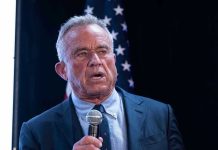
A federal judge has given the green light for President Donald Trump’s administration to proceed with mass layoffs of federal workers, including thousands of IRS employees.
Key Takeaways
- U.S. District Judge Christopher Cooper denied a union motion to temporarily block layoffs of federal workers.
- Around 6,700 IRS probationary employees have been laid off as part of Trump’s government streamlining efforts.
- The ruling affects thousands of federal employees laid off during the first month of Trump’s second term.
- Unions argue that Trump’s actions conflict with Congress’ authority over federal workforce size and layoff procedures.
- The Department of Government Efficiency, led by Elon Musk, is involved in implementing the layoffs.
Judge’s Ruling Allows Federal Layoffs to Proceed
U.S. District Judge Christopher Cooper has denied a motion from unions to temporarily block the layoffs of thousands of federal workers, citing the need to follow federal employment law processes. This decision allows President Donald Trump’s administration to move forward with its plan to reduce the size of the federal workforce, particularly affecting probationary employees at the Internal Revenue Service (IRS).
The ruling impacts approximately 6,700 IRS workers on probation who have been laid off as part of the administration’s efforts to streamline government operations. These employees, many of whom were part of IRS enforcement teams, have been instructed to return government-issued IDs and laptops. The timing of these layoffs, close to the U.S. tax filing deadline, has raised concerns about potential impacts on tax collection and enforcement capabilities.
🚨 Trump's Federal Layoff Plan Proceeds After Positive Court Ruling 🚨
On February 20, 2025, a federal judge allowed the Trump administration to continue its mass firings of federal workers, affecting agencies like the TSA and IRS.
This decision came after legal challenges… pic.twitter.com/hUBTvy0vRH
— Tony Seruga (@TonySeruga) February 20, 2025
Union Response and Legal Challenges
The National Treasury Employees Union and other labor organizations sought a temporary restraining order to halt the layoffs, which was ultimately denied by Judge Cooper. The court ruled that jurisdiction for such claims lies with the Federal Labor Relations Authority, effectively redirecting the unions’ efforts to challenge the layoffs through alternative legal channels.
Doreen Greenwald, president of the National Treasury Employees’ Union, expressed disappointment with the decision but remained optimistic about future legal proceedings. The lawsuit is one of over 80 challenging Trump’s executive orders, indicating widespread opposition to the administration’s approach to federal workforce management.
Department of Government Efficiency and Elon Musk’s Role
The Department of Government Efficiency (DOGE), headed by Elon Musk, plays a significant role in implementing these layoffs. Musk’s involvement has added a layer of controversy to the situation, with legal challenges against his authority and cost-cutting measures receiving mixed rulings in various courts.
In addition to the layoffs, a mass buyout plan for federal workers was temporarily frozen but later lifted. Over 75,000 federal employees accepted buyout offers from the Office of Personnel Management, highlighting the extensive reach of the administration’s workforce reduction efforts.
Implications and Ongoing Debates
The decision to allow these layoffs has ignited political debates surrounding the IRS’s human resource distribution strategy and the broader economic impacts of administrative cost-cutting under Trump’s governance. Critics argue that reducing the IRS workforce, especially enforcement personnel, could lead to decreased tax revenue collection and potentially increase the federal deficit.
As legal challenges continue and affected workers express concerns about financial hardships, the long-term consequences of these workforce reductions remain a subject of intense scrutiny and debate.









